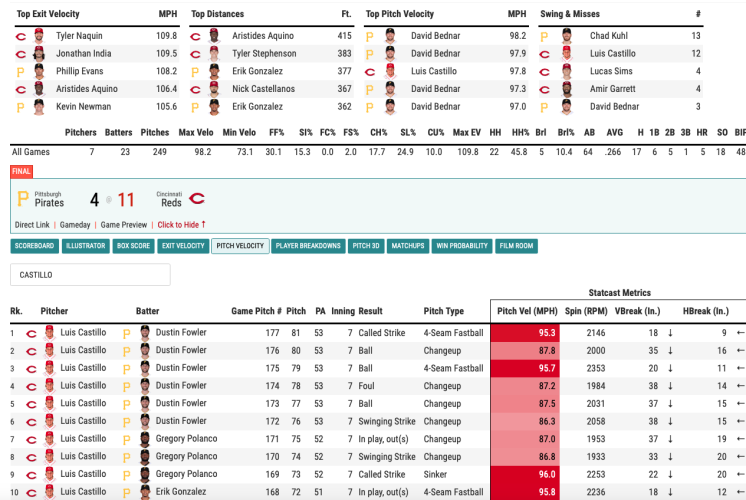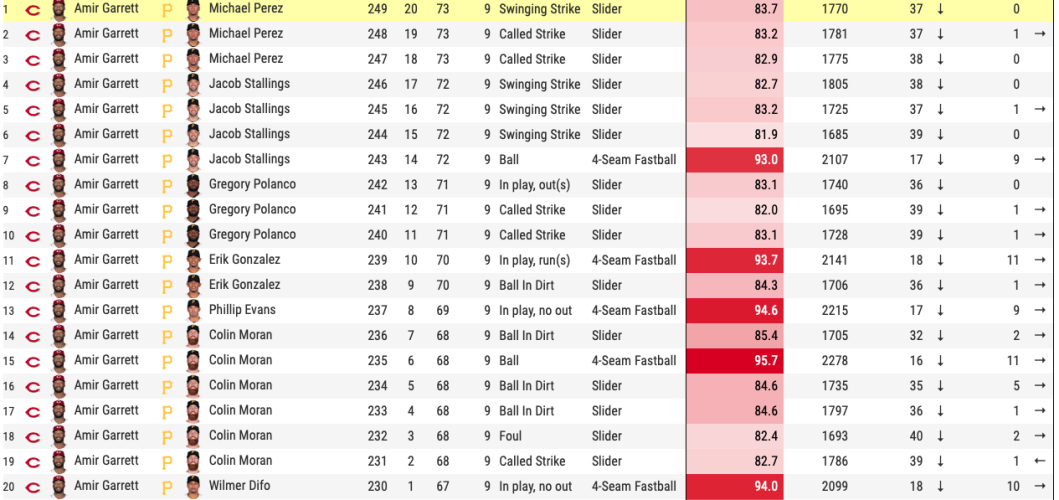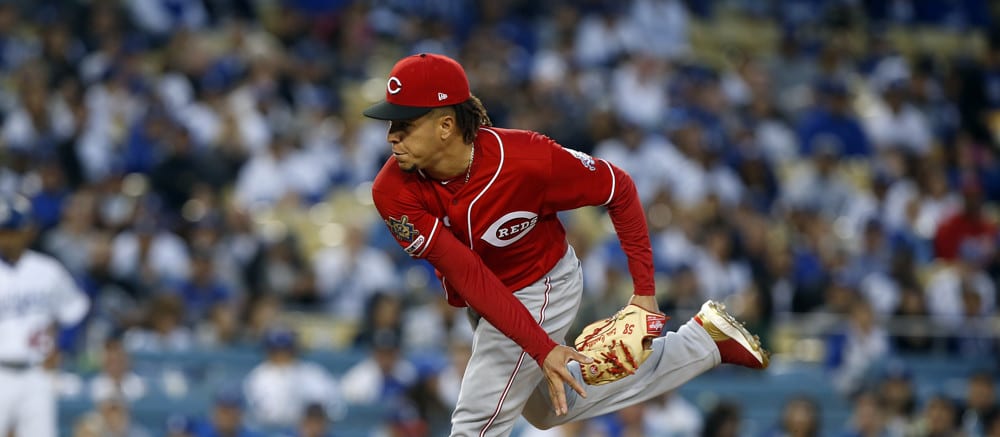This article is part of our Rounding Third series.
Luis Castillo had an awful Opening Day, allowing 10 runs (eight earned) over 3.1 innings without striking out a batter. His average fastball velocity was 95.4 mph, 2.1 mph slower than his 2020 velocity. Wednesday's start went much better against the Pirates - Castillo threw seven shutout innings, striking out five while allowing four hits and a walk. I was asked on Twitter about Castillo's velocity:
@Jeff_Erickson any concern over his velocity? Still down a tad https://t.co/zn7geZheuL
— Kyle d (@kjhoops23) April 7, 2021
To be honest, I didn't know the answer on how to look up pitch-by-pitch velocity for a pitcher on the day he pitched. Clearly while I've spent time on Baseball Savant and Brooks Baseball, it hasn't been nearly enough.
I should already know this, but I don't - is there anywhere one can find velocity numbers for a pitcher, let's call him Luis, on the day of his start? I looked at Savant and Brooks and couldn't find it - perhaps looking in the wrong spot?
— Jeff Erickson (@Jeff_Erickson) April 7, 2021
I had been looking at the player pages on Castillo on both sites, but while I was close with Savant, I was looking at the wrong spot. Fortunately, both Tyler Bischoff and Mike Kurland steered me in the right direction. All I needed to do was to use the boxscores on Baseball Savant and everything is there. I don't think I'll need to look at another conventional box score again. Just look at
Luis Castillo had an awful Opening Day, allowing 10 runs (eight earned) over 3.1 innings without striking out a batter. His average fastball velocity was 95.4 mph, 2.1 mph slower than his 2020 velocity. Wednesday's start went much better against the Pirates - Castillo threw seven shutout innings, striking out five while allowing four hits and a walk. I was asked on Twitter about Castillo's velocity:
@Jeff_Erickson any concern over his velocity? Still down a tad https://t.co/zn7geZheuL
— Kyle d (@kjhoops23) April 7, 2021
To be honest, I didn't know the answer on how to look up pitch-by-pitch velocity for a pitcher on the day he pitched. Clearly while I've spent time on Baseball Savant and Brooks Baseball, it hasn't been nearly enough.
I should already know this, but I don't - is there anywhere one can find velocity numbers for a pitcher, let's call him Luis, on the day of his start? I looked at Savant and Brooks and couldn't find it - perhaps looking in the wrong spot?
— Jeff Erickson (@Jeff_Erickson) April 7, 2021
I had been looking at the player pages on Castillo on both sites, but while I was close with Savant, I was looking at the wrong spot. Fortunately, both Tyler Bischoff and Mike Kurland steered me in the right direction. All I needed to do was to use the boxscores on Baseball Savant and everything is there. I don't think I'll need to look at another conventional box score again. Just look at all this info:

You can see the velocity of every pitch, you can view every pitcher in the game or just a particular pitcher, you can sort by hitter, you can see the spin on each pitch - it's truly incredible. I feel as if I've stepped onto the set of Aladdin:
Going back to Castillo, you can see that he topped out at 97.8 mph, he last hit 97.0 mph late in the fourth inning at pitch 40, and he was working in the 95's in his last inning, topping out in the seventh inning at 96.0. It's not as high as last year yet, but it was definitely a step up over last week.
While I was on Savant looking at this boxscore, I had to dig into Amir Garrett's ugly outing today. Garrett allowed the first four hitters to reach while "protecting" an 11-0 lead in the ninth inning, culminating in Erik Gonzalez's grand slam. He then got the next three batters out, two on strikeouts, but this was another "get work" outing for a closer gone wrong. The noteworthy part of this though was the pitch-type on all the damage.

Garrett threw five fastballs, and not a single one of them netted a positive result. Two were taken for balls, and the other three were all hit hard, with an exit velocity over 100 mph on each, all for hits. Wilmer Difo doubled on Garrett's first pitch, Phillip Evans lined a single on Garrett's third fastball, and Gonzalez hit his grand slam on Garrett's fourth fastball.
In the past, when Garrett has struggled, it's been with his fastball. His slider is his best pitch, but unless your name is Mariano Rivera, if you're a closer you still need two effective pitches. This makes two homers in two outings for Garrett against right-handed hitters. That fastball was effective in spring training, but it's still a work in progress. If you drafted Lucas Sims hoping for some saves, make sure to hang onto him.
A Note About Exit Velocities
Alex Chamberlain is a super smart guy that you should follow - he's already won a couple of FSWA awards for his writing in our community and generally is a sharp analyst. He cautions us to pump the brakes a little bit when we see hitters setting personal records for exit velocities:
again, taking a moment to be the wet blanket that suggests most hitters will set new PRs for max EV this year given what i understand to be the specs of the new ball
(now, please proceed with your rightful and deserved celebration of juan goato) https://t.co/WIA72m2m5C
— Alex Chamberlain (@DolphHauldhagen) April 6, 2021
I know that I've been guilty of doing just that, notably with Byron Buxton and his homer on Tuesday, setting his personal record for exit velocity at 114.1 mph:
(Highlight once again comes from MLB.com's amazing Film Room - I'll be going to the well frequently with this the rest of the year.)
The note of caution doesn't really take away from the wonder of Buxton's particular homer, but as Alex discusses on his Twitter thread, our ability to track growth from gain in average exit velocity is hampered by the notion that the new ball might have more drag but is also springier at its core, which leads to greater velocities, at the cost of some distance due to drag.
Speaking of Velocities
On Friday night, I was watching the Reds-Diamondbacks broadcast and Chris Welsh brought up an interesting point - the average Major League fastball, including all pitchers, is 92.7 mph, which not shockingly is an all-time high. I'm not surprised that records are being set - after all, places like Driveline Baseball and various other pitching academies are in vogue, and especially so with the Reds, who hired Driveline founder Kyle Boddy to be their Director of Pitching, and essentially reshape the way they develop pitchers. But the number is startling to me, even accounting for that. And if you look at Fangraphs numbers (I don't know which source Chris was citing), that velocity is even higher at 93.4 mph.
Jeff Zimmerman chimed in on the thread and pointed out that pitchers are also throwing fewer fastballs than ever, too, at 50.5% of the time. The rate of fastballs thrown had been in steady decline for a while, but sharply declined from 2018 (54.9%) to 2019 (52.5%) down to the current rate. Pitchers can get away with this in part because they're not being asked to throw as many pitches, and because teams can carry more pitchers on the roster. Will we see a higher attrition rate with the increase use of breaking pitchers, particularly sliders? Perhaps, though it might be difficult to prove a causal link, given everything that's been different about the last two seasons.










